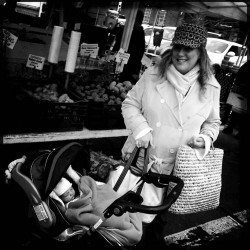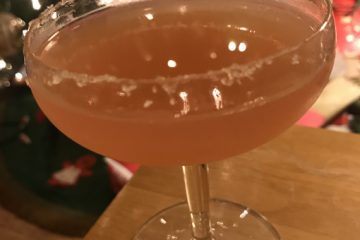Sour Cherry Farm — the place — is our 50-foot by 137 1/2-foot lot (that’s 0.15 of an acre) in the Lower Hudson Valley, 15 miles north of New York City.
We grow sour cherries, pears, blueberries, currants, tomatoes, lettuces, carrots, onions, celery, zucchini, lots of herbs and flowers for cutting and just admiring. We try to cook, eat and drink by the seasons.
 Sour Cherry Farm — the website — is us doing our best at eating from the garden while keeping one foot in the modern world. We don’t claim to be locavores — we just happen to like delicious food, and it’s usually most delicious when it’s fresh from our garden.
Sour Cherry Farm — the website — is us doing our best at eating from the garden while keeping one foot in the modern world. We don’t claim to be locavores — we just happen to like delicious food, and it’s usually most delicious when it’s fresh from our garden.
Our motto is Eat. Drink. Live. — which gives us a lot of leeway when it comes to what we post here. Recipes, restaurants and travel — all, of course, with cocktails, highballs or on the rocks. We started our site in 2006, but moved to new software in March 2010. The first four years of recipes, restaurants, cocktails and camaraderie are archived here: SourCherryFarm.com/archive.
If you’d like to read an official version of how Sour Cherry Farm came to be, Click to open (or download) the PDF of this piece published in Arrive magazine.
Here’s a more casual version:
Back when we lived the urban life, I started experimenting with jellies and jams. One summer, mom and I hit on a good recipe for sour cherry preserves. We got together for an afternoon of boiling water and cooking down fruit and made a couple pints. It was damn delicious.
I continued the tradition for a couple years, and, when it came to be that our wedding date would fall right during the season, we decided that for wedding favors, we’d give out little 1-ounce jars of sour cherry preserves. You know, like the size you get on a room-service breakfast tray. My college roommate owns a pasta sauce company, so she ordered 200 jars from her supplier, and we were ready to go.
For a few years before this, sour cherries had been appearing the third week in June and lasting through the Fourth of July. But 2001 had a cool spring, and the cherries were running late. We panicked.
I called farms throughout the Hudson Valley, hoping (praying) that someone would have ripe sour cherries. We found them at Locust Grove Farm on the banks of the Hudson; likely the waterfront location had something to do with their being earlier there, even though it was further north.
Greg drove up to collect the 30-pound box of cherries. All my girlfriends were roped in to help wash, pit, stem, measure, stir, boil, sanitize and fill jars. We also tied a place card with a guest’s name to each jar with raffia and used them as place cards at the tables. (And to create the seating chart: I have this hilarious memory of my sister and I looking at the dining room table with 150 1-ounce jars of sour cherry preserves gathered in groups of 10. “No, move such-and-so to this table,” she say, and I’d pick up two jars of jam and seat them with someone else.)
Most people were quite taken with the idea that we’d spent time making a favor for them from scratch (much less impressed with the genius of doubling it as a place card!) Of course, some people forgot their jars when they left the wedding. (You expected it wouldn’t be a good party?) I even had one guest say to me later: “Hey, I didn’t realize you’d made the jam. I forgot mine — would you be able to get it for me?”
A year later, when we bought the farm, we immediately planted a sour cherry tree. The name of the farm was a natural.
Later, we talked about how appropriate sour cherry preserves really were as a wedding favor. Sour cherries are a good metaphor for a marriage: They don’t taste very good until you add sugar. You have to treat them gingerly, because they’re fragile and bruise easily. They only grow in places where it gets below freezing in winter for long periods — like Minnesota and the Hudson Valley. And their season may be ephemeral and fleeting, but you can keep them for a very long time if you make the effort to preserve them.




